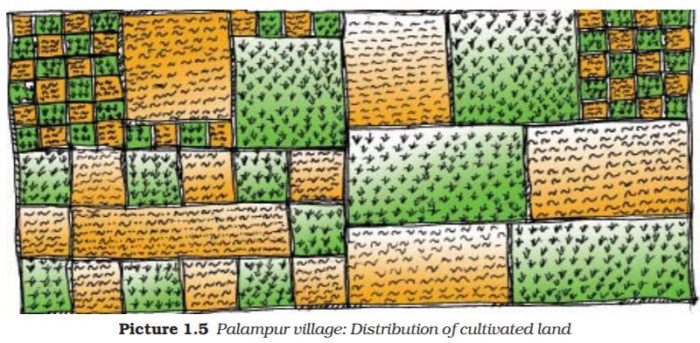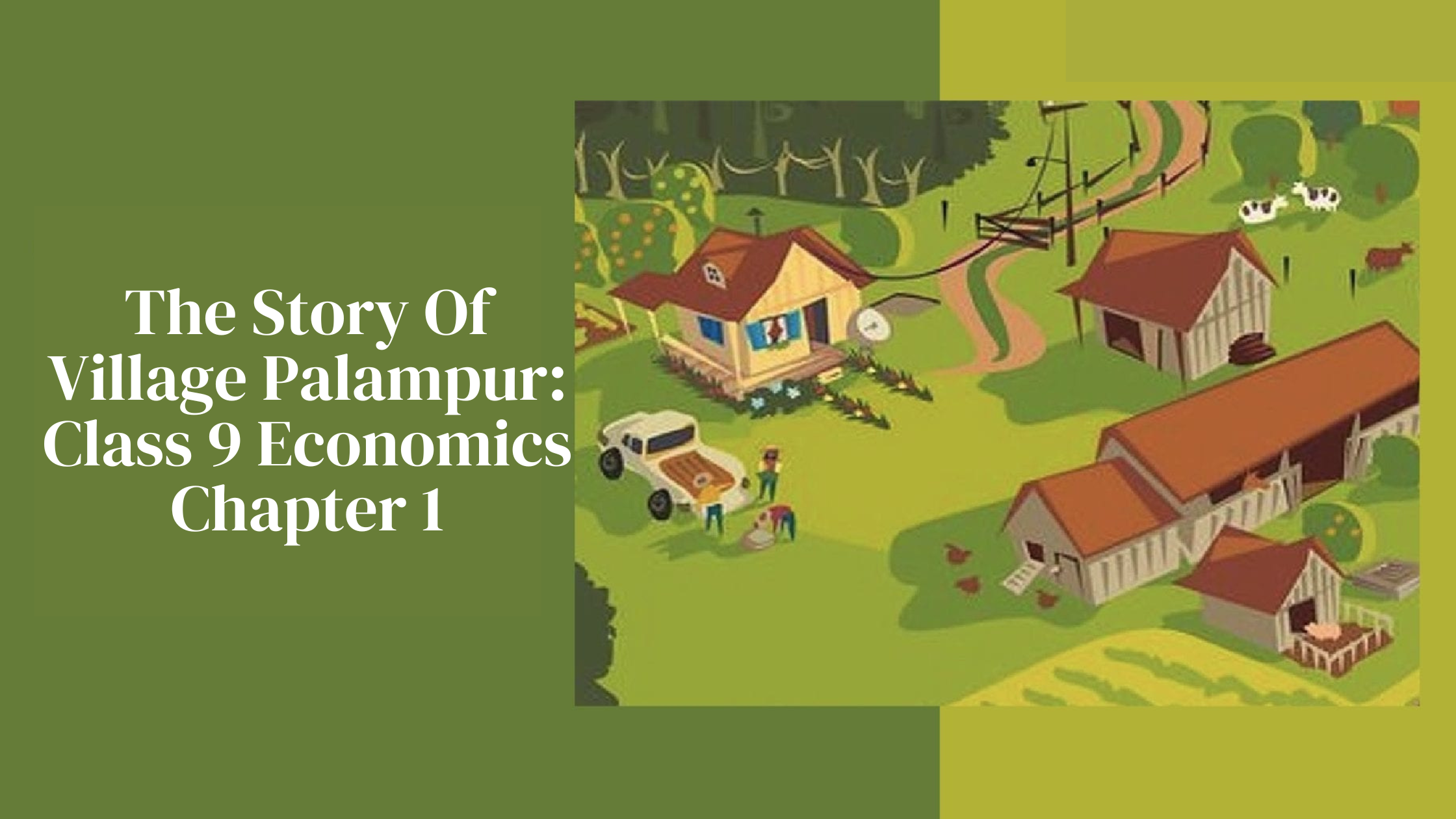We are providing you with short and detailed notes of class 9th economics chapter 1 The Story Of Village Palampur along with the ncert solutions. Students would be able to clear their concepts before examination and get the gist of the lesson.
The purpose of this story is to introduce some basic concepts relating to the production and here this is done and shown to you with the help of the hypothetical village Palampur.
The village Palampur is well-connected with a system of roads and with basic infrastructure like health centers, transport, schools, irrigation facilities. The story takes us through the different production activities.
Organization of Production
The main aim of production is to produce goods and services, which require four essential components.
- Land and other natural resources such as water, forests, minerals
- Labour whether skilled, semi-skilled, or unskilled.
- Physical Capital such as tools, machines, buildings, raw materials, and money
The fourth requirement is knowledge and enterprise to be able to put together land, labor, and physical capital and produce an output.
The factors of production are a combination of land, labor, physical capital, and human capital. Human resources are the best to put all the physical and tangible resources together.
Farming in Palampur
1. Land is fixed
The main production activity is farming and its allied activities. There is a constraint in the farm production to raise and grow as land is fixed in the village.
2. Is there a way one can grow more from the same land?
- In the rainy season, Kharif crops like jawar and bajra are followed by the cultivation of potatoes between October and December.
- In winter, farmers grow wheat and a part of the land is devoted to sugarcane harvested once every year. Due to well-developed irrigation, farmers can grow three different crops. Electricity transformed the system of irrigation.
- Multiple cropping means to grow more than one crop on a piece of land for a higher yield of crops.
- In the later 1960s, the Green Revolution introduced the Indian farmer to the cultivation of wheat and rice using high-yielding varieties (HYVs) of seeds.
3. Will the land be sustained?
Modern farming methods with increased use of natural resources and chemical fertilizers have made the land difficult for further cultivation.
4. How is land distributed between the farmers of Palampur?
The land is important for any kind of farming. In Palampur, about one-third of the 450 families are landless.
Dalits have no land for cultivation. 240 families cultivate small plots of land less than 2 hectares in size.
In Palampur, there are 60 families of medium and large farmers who cultivate more than 2 hectares of land.

5. Who will provide the labor?
Small farmers cultivate their own pieces of land. Medium and large farmers hire laborers who do not have their own land and are willing to work. Laborers do not have the right over the crops grown. They are paid wages in cash or kind. Wages vary from one region to another depending on many factors.
6. Capital needed in farming
1. Small farmers borrow money from larger farmers or landlords for various inputs. These loans cost a high rate of interest.
2. The medium and large farmers have their own savings from farming. They are thus able to arrange for the capital needed.
7. Sale of Surplus Farm Products
The crops grown are retained for their own consumption and the surplus is sold out in the market. Medium and large farmers are able to supply wheat and crops to the market.
Non-Farm Activities in Palampur
25 percent of the people working in Palampur are engaged in activities other than agriculture.
1. Dairy — the other common activity
Other than agriculture, some people are engaged in dairy and the milk is sold in the nearby village.
2. An example of small-scale manufacturing in Palampur
People are engaged in small-scale manufacturing which is carried out at home or in the fields. This manufacturing involves very simple production methods.
3. The shopkeepers of Palampur
Traders of Palampur buy various goods from wholesale markets in the cities and sell them in the village. General stores in the village sell a wide range of items like rice, wheat, sugar, tea, oil, biscuits, soap, toothpaste, batteries, candles, notebooks, pens, pencils, even some types of cloth.
4. Transport: a fast developing sector
Transport services include rickshaws, tonga, jeep, tractor, truck drivers, traditional bullock cart, and a bogey. They transport people and goods from one place to another and in return get paid for it.
NCERT Solutions For Class 9 Chapter 1 The Story Of Village Palampur
Q1. Modern farming methods require more inputs that are manufactured in industry. Do you agree?
Yes, for a higher yield one would require a combination of HYV seeds, irrigation facilities, pesticides, tube wells, machinery, and other farm inputs.
Q2. How did the spread of electricity help farmers in Palampur?
Electricity came early in this village and so its major impact was seen on irrigation. Persian wheels can be seen used by farmers to draw water from the wells.
People then started to use electric run tubewells as they were more efficient. The first tube well was installed by the government and after that farmers started to use private tubewells.
By the mid-1970s the entire cultivated area was 200 ha. They also started using multiple cropping – to grow more than one crop on the same piece of land.
The most common way of increasing production on a given piece of land was multiple cropping and farmers by using this grow at least two different crops.
Q3. Is it important to increase the area under irrigation? Why?
Of the total cultivated area, less than 40 % is irrigated even today. In India, farming is dependent on monsoon which is not regular, and therefore, irrigation is required for better yield.
Q4. Why are the wages for farm laborers in Palampur less than minimum wages?
Due to heavy competition for work among the farm laborers in Palampur, people often agree to work for lower wages.
Q5. What are the different ways of increasing production on the same piece of land? Use examples to explain.
Multiple cropping and the use of modern farming methods are some of the ways to increase production on the same piece of land. In multiple cropping, different crops are grown in different seasons of a year.
For example, jowar and bajra grow during the rainy season, followed by potatoes between October and December, and during the winter season, wheat is sown in the fields.
During the rainy season (Kharif) farmers grow jawar and bajra. It is followed by the cultivation of potatoes between October and December. In the winter season (rabi), fields are sown with wheat.
In modern farming, HYV seeds, chemical fertilizers, pesticides, and proper irrigation are used to increase the yield.
Q6. Describe the work of a farmer with 1 hectare of land.
The main work is done by the farmers along with his immediate family members. Major work includes plowing, sowing, churning, harvesting, and taking the products for supply.
Q7. How do medium and large farmers obtain capital for farming? How is it different from the small farmers?
Medium and large farmers obtained loans with high rates of interest from banks or landlords. They put surplus cash by selling their crops for the next season. Small farmers have a small size of plot and cultivation is not possible. The lack of surplus means they again have to borrow for seeds, inputs, etc to cultivate.
Q8. On what terms did Savita get a loan from Tajpal Singh? Would Savita’s condition be different if she could get a loan from the bank at a low rate of interest?
Savita estimated that the working capital itself would cost a minimum of Rs 3,000. She doesn’t have the money, so she decides to borrow from Tejpal Singh, a large farmer.
Tejpal Singh agrees to give Savita the loan at an interest rate of 24 percent for four months, which is a very high-interest rate. Savita also had to promise to work on his field as a farm laborer during the harvest season at Rs 100 per day.
Yes, if she has taken a loan from the bank at a low rate of interest she could concentrate on her land instead of working as a laborer to repay his loan that too at a low wage.
Conclusion
We have penned down the short summary of class 9 chapter 1 The Story Of Village Palampur along with the ncert solutions to help students prepare for their examinations. Students can go through to get a clear idea of the concepts.
Related Articles

